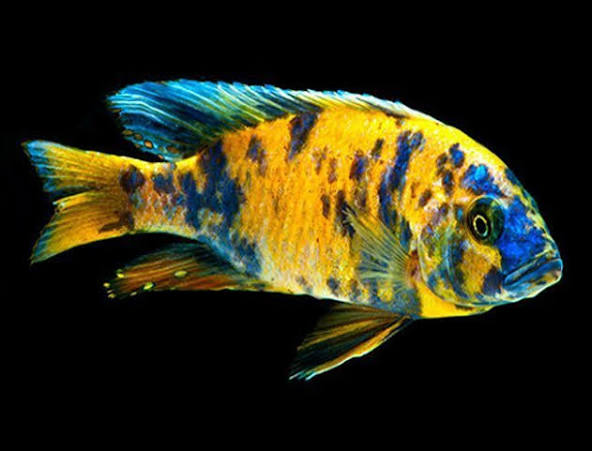1
/
of
1
Midwest Aquarium and Pond Supplier LLC
(115) Orange Blotch (OB) Peacock Cichlid 3in
(115) Orange Blotch (OB) Peacock Cichlid 3in
Regular price
$80.00 USD
Regular price
Sale price
$80.00 USD
Shipping calculated at checkout.
Quantity
Couldn't load pickup availability
The Orange Blotch (OB) Peacock Cichlid (Aulonocara sp. hybrid) is a man-made variant created by crossing a male peacock cichlid with an OB mbuna female. Their bodies are covered in irregular patches of orange, yellow, and blue. Though they are not found in the wild, their care is similar to that of other African cichlids from Lake Malawi
Tank and water requirements
- Tank size: A minimum of 55 gallons is needed for a group of OB Peacocks, with 75 gallons or more recommended to accommodate multiple territorial males.
- Substrate: Use a fine sand substrate, as they are bottom-sifters. This mimics their natural feeding behavior and prevents gill damage from coarse gravel.
- Filtration: Robust filtration is essential to maintain the pristine water quality they require. A canister filter or sump system is ideal for larger tanks.
-
Water parameters:
- Temperature: Maintain a stable temperature between 74 and 82°F (23–28°C).
- pH: A high pH of 7.8–8.6 is necessary to replicate their natural Lake Malawi environment.
- Decorations: Aquascape with plenty of rocks, caves, and crevices to create territories and hiding places. Provide open swimming space in the center.
Diet and feeding
- Omnivorous diet: OB Peacocks are omnivores that benefit from a varied diet.
-
Food types:
- Staple: High-quality cichlid pellets and flakes.
- Supplements: Include frozen foods like mysis shrimp, bloodworms, and spirulina to enhance their colors.
- Feeding schedule: Feed small amounts once or twice daily, ensuring all food is consumed within a few minutes to prevent overfeeding and maintain water quality.
Temperament and tank mates
- Semi-aggressive: While generally less aggressive than mbuna cichlids, males can be territorial, especially toward their own kind during breeding.
- Tank mates: They are best kept with other similarly sized and tempered Peacock cichlids (Aulonocara species) and Haps (Haplochromine cichlids).
- Social dynamics: To minimize aggression, maintain a male-to-female ratio of at least 1:3.
Breeding
- Maternal mouthbrooders: Like other peacocks, the female carries the fertilized eggs and fry in her mouth for protection.
- Spawning behavior: The male will court a female, who will lay her eggs in a pit he has dug in the sand. The female then picks up the eggs, and fertilization occurs with the male's help.
- Raising fry: For best results, move a female holding eggs to a nursery tank, as the female may release the fry after about three weeks.
Share
No reviews

